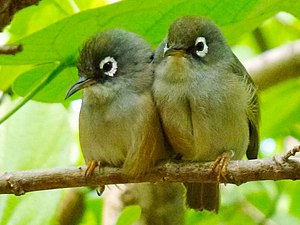Mauritius spectacle bird
| Mauritius spectacle bird | ||||||||||||
|---|---|---|---|---|---|---|---|---|---|---|---|---|

Mauritius spectacled bird ( Zosterops chloronothos ) |
||||||||||||
| Systematics | ||||||||||||
|
||||||||||||
| Scientific name | ||||||||||||
| Zosterops chloronothos | ||||||||||||
| ( Vieillot , 1817) |
The Mauritius spectacled bird ( Zosterops chloronothos ) is a very rare passerine bird from the family of spectacled birds (Zosteropidae). It is endemic to the island of Mauritius . This species was described by the French ornithologist Louis Pierre Vieillot in 1817 .
description
The Mauritius spectacle bird reaches a length of approx. 10 cm. The top is matt olive green, the underside is pale in color. The belly and rump have a yellow tint. There is a noticeable white ring around the eyes. Males and females look alike.
habitat
The habitat of the Mauritius spectacle bird are evergreen bushes and forests in the area of the Black River Gorge National Park and the Macchabée-Bel-Ombre Biosphere Reserve.
Way of life
Its diet consists of nectar, fruits and insects. During the breeding season from September to March, two greenish eggs are laid in a cup-shaped nest that is well hidden in the foliage. The nest is set up by both parents and attached to thin branches with cobwebs. Both parents take part in raising the young. As a rule, one or two young birds are raised, which fledge after 14 days.
Danger
The Mauritius Spectacled Bird is one of the rarest birds in Mauritius. The birds, which are difficult to observe, live in an area of 25 km². The main threats are introduced monkeys and rats who raid the nests. The stock decreased within 25 years from 700 copies in 1975 to only 120 pairs in 2002. As a food specialist, he feeds on the nectar and fruits of certain native flowers, another dramatic decline is also due to the invasive plants that have displaced his food crops.
In 2005, the Mauritius Wildlife Foundation started a reintroduction program to save the species. To this end, between 2005 and 2011, young birds were removed from their nests in Combo, the last known habitat of the species, and brought to the coastal island of Ile aux Aigrettes , which is free of predators . They were raised by hand and released into the wild as adults. The birds have established themselves in the meantime and breed successfully every year. In August 2012, 31 adult birds were counted. The population is monitored extensively and behavior is recorded to understand, for example, which plants the birds depend on most or when they breed. All detected nests a place monitoring takes place and the young birds are ringed still in the nest. In addition, the birds in Combo are regularly searched for and monitored.
Web links
- Zosterops chloronothos inthe IUCN Red List of Threatened Species 2015.4. Posted by: BirdLife International, 2012. Retrieved February 3, 2016.
- Mauritian Wildlife Foundation - Olive White-eye
- Birdlife factsheet
- Olive White-Eye. Encyclopaedia Mauritiana, archived from the original on April 11, 2008 ; Retrieved May 6, 2013 .

